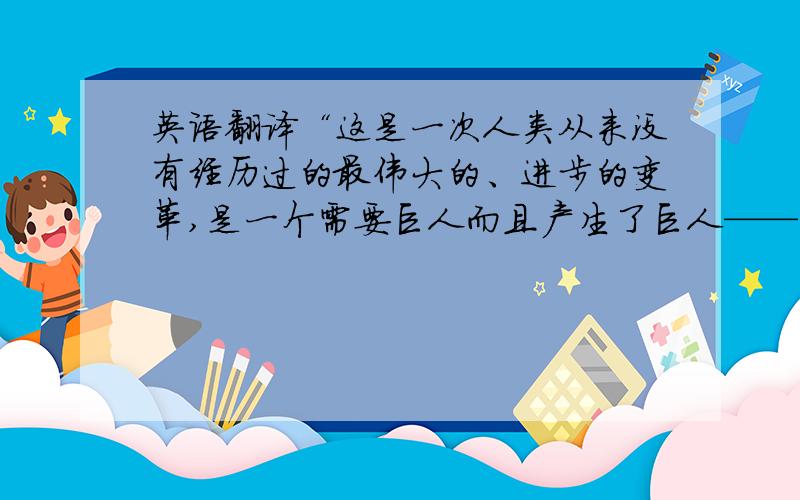英语翻译“这是一次人类从来没有经历过的最伟大的、进步的变革,是一个需要巨人而且产生了巨人——在思维能力、热情和性格方面,
来源:学生作业帮 编辑:大师作文网作业帮 分类:英语作业 时间:2024/11/18 16:06:56
英语翻译
“这是一次人类从来没有经历过的最伟大的、进步的变革,是一个需要巨人而且产生了巨人——在思维能力、热情和性格方面,在多才多艺和学识渊博方面的巨人的时代.”谁能帮我把这句翻译一下啊,要准确点的,最好是英文版的恩格斯选集的原文.
“这是一次人类从来没有经历过的最伟大的、进步的变革,是一个需要巨人而且产生了巨人——在思维能力、热情和性格方面,在多才多艺和学识渊博方面的巨人的时代.”谁能帮我把这句翻译一下啊,要准确点的,最好是英文版的恩格斯选集的原文.

Leonardo di ser Piero da Vinci (pronunciation (help·info)), April 15, 1452 – May 2, 1519) was a prominent Italian polymath: scientist, mathematician, engineer, inventor, anatomist, painter, sculptor, architect, musician and writer.
The illegitimate son of a notary, Messer Piero, and a peasant girl, Caterina, Leonardo had no surname in the modern sense, "da Vinci" simply meaning "of Vinci": his full birth name was "Leonardo di ser Piero da Vinci", meaning "Leonardo, son of (Mes)ser Piero from Vinci."
Leonardo has often been described as the archetype of the "Renaissance man" or universal genius, a man whose seemingly infinite curiosity was equalled only by his powers of invention. He is widely considered to be one of the greatest painters of all time and perhaps the most diversely talented person ever to have lived.[2]
It is primarily as a painter that Leonardo was and is renowned. Two of his works, the Mona Lisa and The Last Supper occupy unique positions as the most famous, most reproduced and most imitated portrait and religious painting of all time, their fame approached only by Michelangelo's Creation of Adam. Leonardo's drawing of the Vitruvian Man is also iconic. Perhaps fifteen paintings survive, the small number due to his constant, and frequently disastrous, experimentation with new techniques, and his chronic procrastination.[3] Nevertheless these few works, together with his notebooks, which contain drawings, scientific diagrams, and his thoughts on the nature of painting, comprise an unmatched contribution to later generations of artists.
As an engineer, Leonardo conceived ideas vastly ahead of his own time, conceptualising a helicopter, a tank, concentrated solar power, a calculator, and the double hull, and outlining a rudimentary theory of plate tectonics. Relatively few of his designs were constructed or even feasible during his lifetime,[4] but some of his smaller inventions such as an automated bobbin winder and a machine for testing the tensile strength of wire entered the world of manufacturing unheralded. As a scientist, he greatly advanced the state of knowledge in the fields of anatomy, civil engineering, optics, and hydrodynamics.
The illegitimate son of a notary, Messer Piero, and a peasant girl, Caterina, Leonardo had no surname in the modern sense, "da Vinci" simply meaning "of Vinci": his full birth name was "Leonardo di ser Piero da Vinci", meaning "Leonardo, son of (Mes)ser Piero from Vinci."
Leonardo has often been described as the archetype of the "Renaissance man" or universal genius, a man whose seemingly infinite curiosity was equalled only by his powers of invention. He is widely considered to be one of the greatest painters of all time and perhaps the most diversely talented person ever to have lived.[2]
It is primarily as a painter that Leonardo was and is renowned. Two of his works, the Mona Lisa and The Last Supper occupy unique positions as the most famous, most reproduced and most imitated portrait and religious painting of all time, their fame approached only by Michelangelo's Creation of Adam. Leonardo's drawing of the Vitruvian Man is also iconic. Perhaps fifteen paintings survive, the small number due to his constant, and frequently disastrous, experimentation with new techniques, and his chronic procrastination.[3] Nevertheless these few works, together with his notebooks, which contain drawings, scientific diagrams, and his thoughts on the nature of painting, comprise an unmatched contribution to later generations of artists.
As an engineer, Leonardo conceived ideas vastly ahead of his own time, conceptualising a helicopter, a tank, concentrated solar power, a calculator, and the double hull, and outlining a rudimentary theory of plate tectonics. Relatively few of his designs were constructed or even feasible during his lifetime,[4] but some of his smaller inventions such as an automated bobbin winder and a machine for testing the tensile strength of wire entered the world of manufacturing unheralded. As a scientist, he greatly advanced the state of knowledge in the fields of anatomy, civil engineering, optics, and hydrodynamics.
恩格斯说:“这是一次人类从来没有经历过的最伟大的.进步的变革,是一个需要巨人而产生巨人——在思维能力,热情和性格方面,在
这是一次人类从来没有经历过的最伟大的进步的变革,是一个需要巨人而且产生了巨人的时代
恩格斯说:“这是一次人类从来没有经历过的最伟大的.进步的变革,是一个需要巨人而产生巨人的时代.
“这是一次人类从来没有经历过的最伟大的、进步的变革,是一个需要巨人而且产生了巨人的……时代”。这场为欧洲资本主义社会的产
一位哲人说过:“这(文艺复兴)是一次人类从来没有经历过的最伟大的、进步的变革,是一个需要巨人并产生了巨人的时代”.下列人
初三上册历史题这是一次人类从来没有经历过的最伟大的进步的改革,是一个需要巨人而且产生巨人的时代,需要巨人且产生巨人的社会
14世纪的文艺复兴恩格斯:文艺复兴是一次人类从来没有经历过的最伟大、最进步的变革.为什么说文艺复兴是当时“最伟大、最进步
恩格斯说:“这(指14世纪兴起的一场运动)是一次人类从来没有经历过的最伟大的.最进步的变革.”
思格斯说:“这(指14世纪兴起的一场运动)是一次人类从来没有经历过的最伟大的、最进步的变革.”
恩格斯说:“这是一次人类从来没有经历的最伟大的、进步的改革.”指什么事件
恩格斯 "这是一个需要巨人而且产生巨人的时代"出自哪一部著作?
为什么恩格斯说文艺复兴时期是一个既需要巨人而且产生巨人的时期